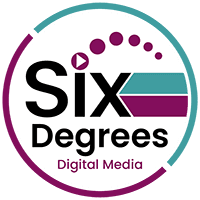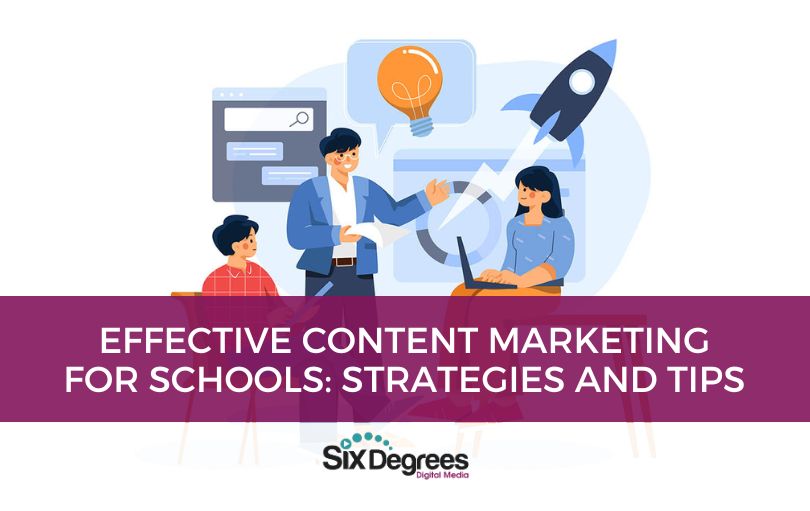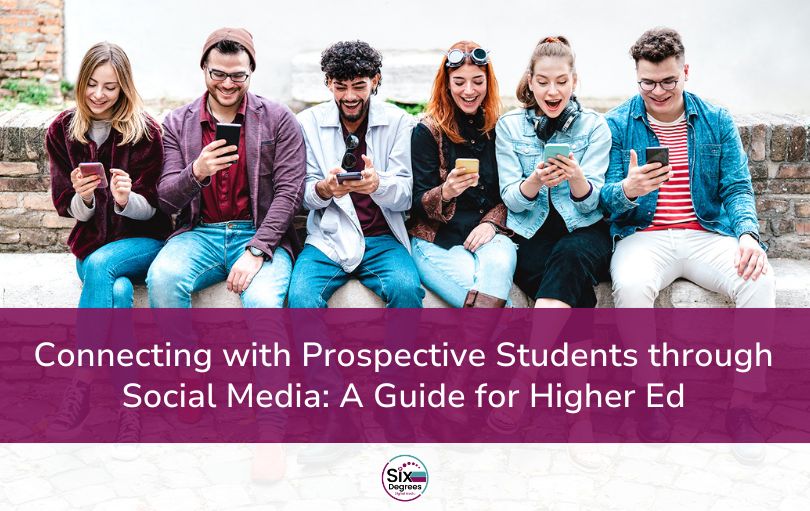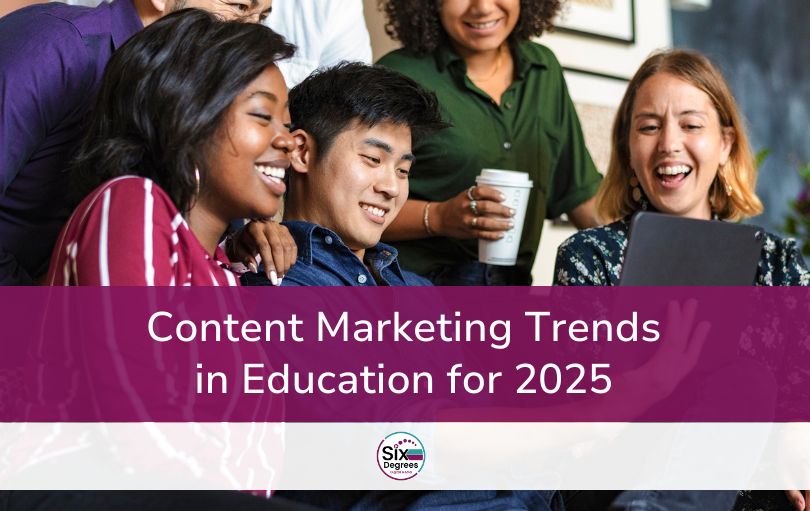For schools seeking to enhance student engagement, visibility, and enrollment rates, a well-crafted content marketing strategy is a powerful compass that guides them through the dynamic landscape of higher education marketing.
This blog post is your comprehensive guide to leveraging the potential of content marketing to its fullest extent.
The Benefits of Content Marketing for Schools
Limited resources, a rapidly evolving digital landscape, and the need to know what marketing strategies are even working can leave you searching for solutions that yield impactful results. Crafting a well-structured content strategy can serve as the compass guiding you through these challenges, steering your institution toward success in the higher education market.
Maximizing Impact with Limited Resources
Budget constraints and a small marketing team can make it difficult to hit your enrollment goals. A focused content strategy helps you get the most out of the limited resources at your disposal.
Here’s how content marketing can be a game-changer for marketing teams facing resource limitations:
- Versatility: Content marketing is incredibly versatile, allowing you to repurpose and adapt content across various platforms, saving time and effort.
- Cost-Effectiveness: Creating valuable content is often more cost-effective than traditional advertising methods, stretching your budget further.
- Long-Term Impact: High-quality content has a longer shelf life, providing ongoing value and engagement even after its initial release.
- Audience Targeting: With a deep understanding of your audience, content can be precisely tailored to resonate with their preferences and needs.
- Organic Reach: Compelling content can attract organic traffic, reducing the need for heavy investment in paid advertising.
- Thought Leadership: Consistently producing insightful content can position your institution as a thought leader in the field, building credibility.
- Community Building: Engaging content fosters a sense of community, encouraging interactions and discussions among your audience.
Whether it’s through compelling blog posts, engaging social media campaigns, or informative videos, content can be fine-tuned to align with your institution’s core values and programs. This approach increases the impact of your marketing initiatives while highlighting your institution’s strengths in a way that matters to your target audience.
An Adaptable Approach
A well-crafted content strategy is like a chameleon, capable of adapting to the quick changes in digital marketing trends.
This approach ensures that your institution’s online presence remains fresh and engaging through:
- Interactive Content: Engaging formats such as quizzes, polls, and interactive videos capture audience attention and foster participation.
- Emerging Platforms: Staying updated on new social media platforms and channels ensures your institution reaches students where they spend their time.
- Voice Search Optimization: As voice assistants become more prevalent, optimizing content for voice search improves your institution’s discoverability.
- Personalization: Adapting content to individual preferences enhances user experience and builds stronger connections.
- Data Utilization: Leveraging data analytics helps refine your strategy based on real-time insights.
- Mobile Responsiveness: Ensuring content displays well on mobile devices is essential for meeting the preferences of modern users.
Evergreen content (timeless articles, guides, or infographics) can provide a consistent stream of organic traffic long after their publication. These valuable resources become go-to references for students seeking reliable information, solidifying your institution’s reputation as a knowledgeable source. By incorporating evergreen content into your strategy, you create a lasting impact that continues to attract and engage prospective students.
Crafting Your Custom Content Strategy
Step 1: Audience Research –Insights that Matter
At the heart of any effective content strategy lies a deep understanding of your target audience. By delving into the preferences, pain points, and aspirations of prospective students, you gain invaluable insights that shape your content creation process. This knowledge equips you to produce content that speaks directly to your audience’s needs, sparking genuine connections and engagement.
The best research tool that you have is your current student base. Ask incoming students what sparked their interest in your school and what they are excited to learn. What problems do they have that enrolling in your school will help them fix?
The ultimate goal when understanding prospective students is to build out the transformation that they will undergo. What is their “before state” – what do they struggle with or want to achieve prior to enrollment? What does their average day look like? How do those change after they enroll? How about after they graduate? That leads us into Step 2.
Step 2: Content Mapping – Guiding the Student Journey
As you know, the student journey has multiple stages, from that first spark of awareness to the triumphant moment of enrollment. Your content strategy should serve as a guiding light, leading potential students through this journey.
Mapping content to each stage ensures that you’re delivering the right message at the right time. Informative blog posts, engaging social media stories, and inspiring testimonials are just a few content types that can resonate with your audience at different stages.
A student who has never heard of you and isn’t sure what they are looking for will benefit greatly from a piece that can entertain them or shock them with statistics that draw in their curiosity.
Someone on the cusp of choosing a school needs a little nudge towards your enrollment team through alumni stories and testimonials.
Step 3: High-Quality Educational Content – Showcasing Expertise
Knowledge is power. Elevate your content strategy by crafting educational materials that showcase your institution’s expertise. Addressing the questions and concerns that potential students might have demonstrates your commitment to their success.
When your content takes a proactive stance in addressing the challenges and concerns faced by prospective students, you’re not just showcasing empathy – you’re demonstrating a sincere commitment to their journey. Here’s how:
- Problem-Solving: Craft content that directly tackles pain points, providing solutions and guidance.
- Financial Support: Offer insights into scholarships, financial aid, or part-time work opportunities.
- Allyship: Position your institution as an ally by understanding and addressing the struggles prospective students face.
- Empathy: Build rapport and foster a connection that extends beyond the initial interaction.
By approaching content creation with empathy and practical solutions, your institution builds a relationship rooted in understanding and support.
Step 4: Engaging Visual Content – Capturing Hearts and Minds
We are visual creatures. The impact of video marketing and visually appealing content cannot be overstated. Engaging videos offer a window into your institution’s culture, faculty, and facilities, fostering a sense of connection before students even set foot on campus.
Similarly, captivating infographics and eye-catching imagery can convey complex information in a digestible and memorable manner.
But the eye candy doesn’t stop there- make sure that your branding is consistent across the board and that every piece of content from social posts to lengthy blogs is easy to read and beautiful to look at.
Step 5: Consistency and Frequency – Building Momentum
A content strategy’s effectiveness hinges on consistency. Regularly engaging with your audience through thoughtfully crafted content keeps your institution top-of-mind. Establish a publishing schedule that aligns with your audience’s online habits and preferences. Consider:
- Weekly blog posts
- Bi-monthly videos
- Daily social media updates
Maintaining this rhythm ensures that your institution’s brand remains visible and relevant. You have the power to sculpt a content approach that not only tackles challenges head-on but also propels your institution toward its enrollment goals.
Focus Less on Promotion
It’s important to keep in mind that the main objective of content marketing for schools isn’t just about sales. Yes, you want to attract students and encourage them to enroll in your institution. However, if every piece of content screams “Join us now.” or “Buy this course.”, you risk alienating your audience.
The key is balance. Your content strategy should focus less on promotion and more on providing value. This approach helps build awareness about your school and fosters trust with prospective students.
Shifting Focus: Content Strategy Centered on Value, Not Promotion
It’s easy to fall into the trap of using content as a promotional tool alone. However, a paradigm shift is underway—one that places providing value at the forefront of content strategy. Instead of simply pushing your institution’s offerings, the emphasis is on fostering meaningful connections and building trust with prospective students. Here’s why a content strategy geared towards delivering value is the true path to success:
Elevating Credibility: Engaging with Educational Content
By offering content that educates, informs, and genuinely benefits your audience, you’re not just advertising your programs – you’re showcasing your institution’s expertise. When you explore topics that matter to your audience, addressing their questions and concerns, you demonstrate authority in the field. This goes beyond promotion; it’s about establishing a foundation of trust.
In a sea of information, prospective students are more likely to gravitate towards an institution that provides valuable insights. Imagine a student seeking guidance on career prospects in vocational fields stumbling upon your institution’s blog post that comprehensively addresses the topic. Your institution’s credibility skyrockets, and trust begins to form.
Thought Leadership: Sharing Insights that Matter
Value-driven content doesn’t just elevate credibility – it propels your institution into the realm of thought leadership. Here’s how:
- Insightful Sharing: Share valuable insights, perspectives, and analyses to become a reliable source of information.
- Go-To Resource: Your content transforms into a go-to resource for those seeking industry-related information.
- Trusted Advisor: Consistently providing thought-provoking content positions your institution as a trusted advisor.
A content strategy focused on value builds relationships, fosters trust, and establishes your institution’s authority. The next step is exploring how this value-centric approach extends beyond the confines of marketing, shaping the entire student experience.
Guiding Decision-Making: Illuminating the Path Ahead
The decision to pursue higher education is a significant one, often fraught with uncertainty. Value-driven content acts as a guiding light, leading potential students through the complex labyrinth of choices:
- Comprehensive Insights: Offer information about programs, campus life, career prospects, and more.
- Empowerment: Empower students to make informed decisions by providing valuable content.
- Alleviating Doubts: Imagine a prospective student unsure about post-graduation job placement. Content outlining alumni success stories, industry partnerships, and vocational insights can alleviate doubts.
- Clarity and Confidence: Such content equips potential students with the clarity and confidence to take the decisive step towards enrollment.
An empathetic content strategy goes beyond transactional marketing, forging connections and guiding students towards success. It solves problems, illuminates paths, and transforms your institution into a beacon of support and understanding
Cultivating Engagement: Nurturing Relationships Through Interactive Content
But the journey doesn’t end with simply delivering information; you have to take the next step and cultivate meaningful engagement. Embracing a content strategy that encourages interaction can bridge the gap between your institution and potential students, creating an environment where learning, sharing, and connecting flourish.
Interactive Content: Beyond the Promotional Realm
Steering away from solely promotional content opens the door to a world of interactive experiences that captivate your audience. Imagine:
- Quizzes and Webinars: Offer quizzes for exploring vocational interests and webinars on industry trends.
- Engagement Spark: Interactive elements like quizzes and webinars spark engagement and curiosity.
- Dynamic Learning: These interactive features make the learning process dynamic and exciting.
Q&A sessions, whether through live streams or pre-recorded videos:
- Direct Address: Address audience concerns directly through Q&A sessions.
- Community Building: Q&A sessions nurture a sense of community.
- Active Participation: Transform content into an interactive space where students actively engage.
Creating a platform for two-way dialogue through comments and discussions:
- Authentic Connections: Encourage comments to foster genuine connections.
- Understanding and Response: Invite audience thoughts, experiences, and questions for understanding and response.
- Community Hub: This interaction turns your content space into a hub of authentic conversations.
By embracing interactive elements and open dialogues, your content strategy moves beyond transactional marketing into shared experiences and vibrant discussions. This approach captures not just attention, but hearts and minds, fostering an enduring relationship between your institution and its students.
Building Long-Term Relationships: Content Strategy for Lasting Connections
With content, the true measure of success lies not just in immediate conversions, but in the establishment of enduring relationships. A well-crafted content strategy has the potential to cultivate these long-term connections.
Nurturing Prospects: A Journey Beyond Short-Term
A nurture sequence is a series of strategically planned and timed communications that aim to build a relationship with leads or prospects, guiding them through the decision-making process and ultimately encouraging them to enroll. In the context of education, a nurture sequence for prospective students aims to provide valuable information, address their concerns, and nurture their interest in your institution.
Here’s what a nurture sequence for a vocational education program might look like:
- Welcome Email:
- Sent immediately after a prospect signs up or expresses interest.
- Warmly welcomes the prospect to your institution’s community.
- Provides an overview of what they can expect from the nurture sequence.
- Educational Content:
- Share informative blog posts, articles, or videos related to vocational education.
- Address common questions and concerns, such as job placement, program options, and financial aid.
- Showcase success stories of alumni who have benefited from your programs.
- Program Highlights:
- Introduce specific vocational programs or fields of study.
- Highlight unique features, benefits, and career prospects for each program.
- Include links to detailed program pages on your website.
- Interactive Content:
- Offer quizzes or self-assessment tools to help prospects identify their interests and strengths.
- Provide webinars or virtual campus tours to offer an immersive experience.
- Alumni Stories:
- Share in-depth profiles of successful alumni from various vocational programs.
- Highlight their career journeys and the impact of their education.
- Addressing Concerns:
- Send content that directly addresses common concerns, such as work-life balance, time management, and financing options.
- Provide insights and solutions to help prospects overcome potential obstacles.
- Faculty and Expertise:
- Introduce key faculty members and experts in relevant fields.
- Showcase their qualifications and expertise, highlighting their contributions to the student experience.
- Application and Enrollment Process:
- Provide step-by-step guidance on the application and enrollment process.
- Offer assistance for any paperwork, deadlines, or required documentation.
- Virtual Events and Open Houses:
- Invite prospects to attend virtual events or open houses to learn more about your institution.
- Provide opportunities for direct interaction with current students, faculty, and staff.
- Final Call to Action:
- Conclude the sequence with a strong call to action, encouraging prospects to take the next step.
- Provide clear instructions on how to apply, enroll, or request more information.
Throughout the nurture sequence, it’s essential to personalize content based on the prospect’s interests and engagement level. An effective nurture sequence aims to provide value, build trust, and guide prospects towards making an informed decision about their educational journey.
Alumni Engagement: Celebrating Milestones and Success
A well-rounded content strategy extends its reach beyond prospective students to embrace those who have already embarked on their educational journey with your institution. Content that celebrates the achievements of alumni not only showcases your institution’s impact but also reinforces a sense of belonging and community.
Imagine spotlighting an alum who has achieved remarkable success in their chosen field. Sharing their journey, insights, and contributions not only highlights your institution’s role in their development but also inspires current and prospective students. This approach creates a cycle of engagement, where alumni feel connected to your institution and potential students are motivated by real-world success stories.
Tips for Optimizing Content: Enhancing Your Strategy
As you embark on the journey of crafting a content strategy that resonates deeply with your audience, optimizing your approach becomes key. Here are some practical tips to ensure your content remains dynamic, responsive, and finely tuned to meet the needs of potential students.
Keep Updating: Stay Current and Relevant
As new facts, statistics, and developments emerge in the vocational education field, be diligent in updating your content accordingly. Regularly review your content to ensure that the information you’re presenting remains accurate and aligned with the latest industry trends. This commitment to staying current showcases your institution’s dedication to providing reliable and timely insights.
User Feedback: Listening to Your Audience
Your audience’s feedback serves as a treasure trove of valuable insights that can significantly shape your content strategy. Actively seek and carefully analyze comments, questions, and feedback from users who engage with your content. These interactions offer direct glimpses into how well your content aligns with their needs and expectations. By actively listening and engaging, you can harness this user-centric approach to enrich your content and strengthen the bond with your audience.
Collecting User Feedback:
- Comments and Engagement: Monitor comments on blog posts, social media, and other platforms. Take note of recurring themes, questions, and suggestions.
- Surveys and Polls: Create surveys or polls to gather specific feedback on content topics, formats, and preferences.
- Email Feedback: Encourage readers to provide feedback through email. Include a dedicated email address for inquiries and suggestions.
Implementing User Feedback:
- Adapt and Expand: Address specific concerns or questions raised by your audience in future content pieces. Expand on topics that generate high engagement.
- Content Refinement: Use feedback to refine your content’s tone, style, and depth. Tailor your approach to better resonate with your audience.
- New Content Ideas: User feedback can inspire new content ideas. Create content based on the interests and suggestions of your audience.
- Interactive Elements: If users express interest in specific interactive content (quizzes, webinars, etc.), consider incorporating those elements into your strategy.
- Topic Relevance: Regularly reassess your content strategy based on feedback to ensure your topics remain relevant and valuable.
By actively collecting and implementing user feedback, you demonstrate your commitment to addressing their needs and delivering content that truly resonates. This user-centric approach not only improves your content strategy but also fosters a stronger and more meaningful connection with your audience.
Analyze Performance: Data-Driven Insights
Harness the power of data to fine-tune your content strategy and achieve optimal results. Utilize tools like Google Analytics to access detailed reports on user interactions with your website and its content. By analyzing key metrics, you can gain valuable insights into what resonates with your audience and identify areas for improvement. This data-driven approach empowers you to make informed decisions, ensuring that your content strategy effectively aligns with your goals and audience preferences.
Metrics to Analyze and What You Can Learn:
- Page Views: Measure the popularity of different pages and content pieces.
- Learn which topics and formats are capturing the most attention.
- Bounce Rates: Assess the percentage of visitors who leave your site after viewing only one page.
- Determine if your content is engaging enough to encourage further exploration.
- Time on Page: Analyze the average time users spend on specific content pages.
- Understand which pieces are holding users’ attention longer and providing value.
- Click-Through Rates: Track the percentage of users who click on links within your content.
- Identify the effectiveness of your calls to action and internal linking strategies.
- Conversion Rates: Measure how many users complete desired actions (e.g., filling out a form, subscribing).
- Gauge the impact of your content in driving meaningful engagement and conversions.
- User Behavior Flow: Visualize the path users take through your website.
- Pinpoint popular entry points, content progression, and potential drop-off points.
- Referral Sources: Determine where your traffic is coming from (e.g., social media, search engines).
- Optimize your content distribution strategy based on successful referral channels.
By analyzing these metrics, you can glean insights into your audience’s preferences, content effectiveness, and engagement patterns. This knowledge empowers you to adjust your content strategy to better serve your audience, refine your messaging, and ultimately enhance the impact of your content efforts.
A/B Testing: The Art of Experimentation
Experimentation is a cornerstone of optimization. A/B testing allows you to experiment with different versions of a piece of content, be it headlines, images, or even layout choices. By presenting two variations to different segments of your audience and comparing their performance, you can discern which version drives higher engagement or conversions. Platforms like Optimizely offer tools that streamline this testing process, helping you refine your content for maximum impact.
If you’re ready to take your content marketing efforts to the next level and witness tangible results, schedule a call with us! Our team of experts is here to help you fill your program seats through engaging content. Contact us today for a free strategy session and get ready to boost student engagement, enhance visibility, and achieve your enrollment goals.








